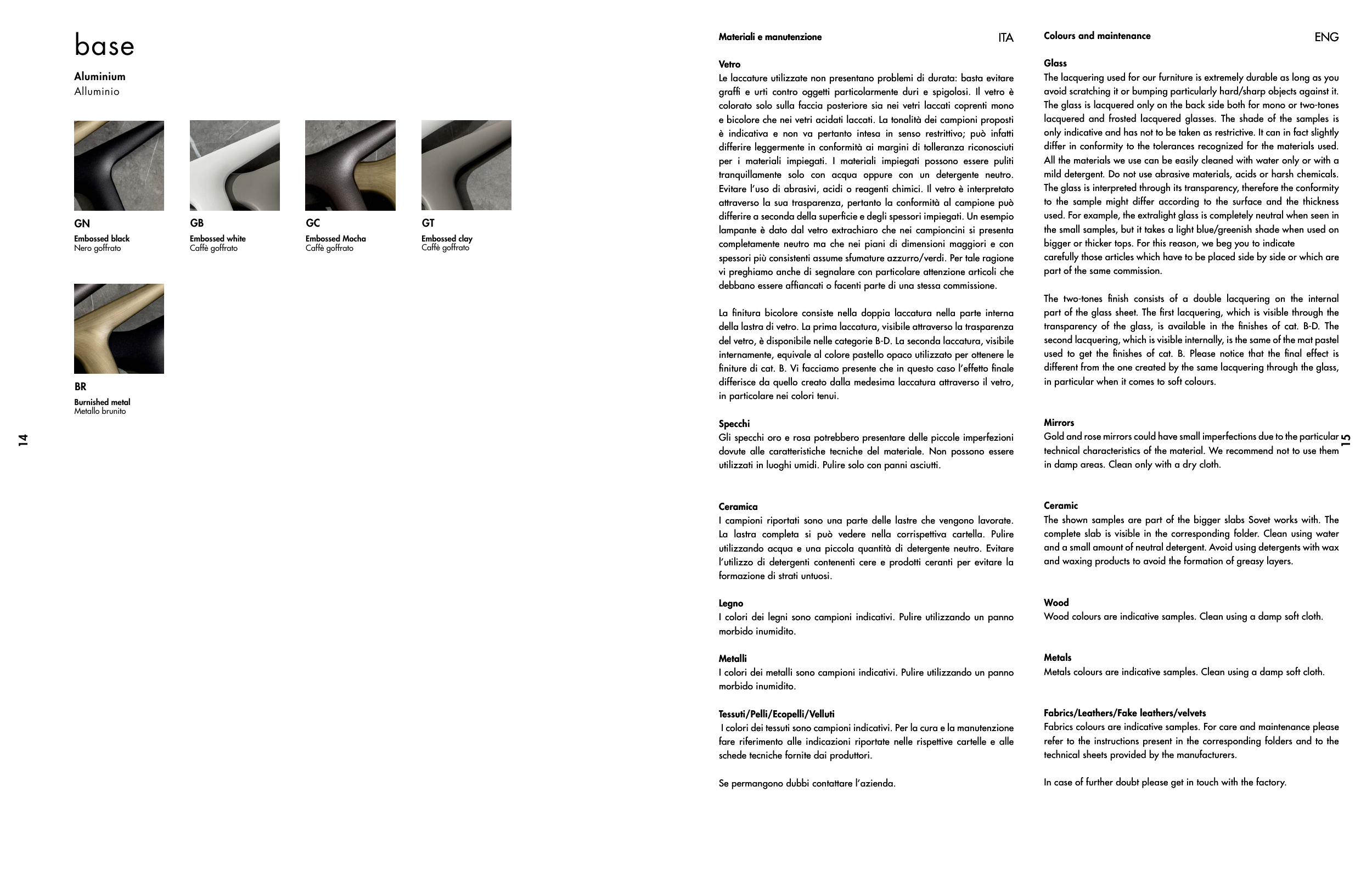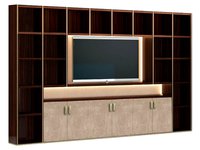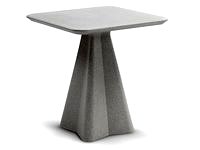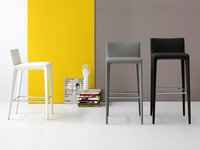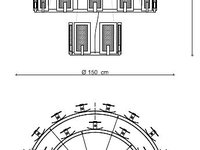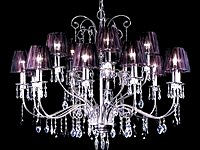14
15
Colours and maintenance
Glass
The lacquering used for our furniture is extremely durable as long as you
avoid scratching it or bumping particularly hard/sharp objects against it.
The glass is lacquered only on the back side both for mono or two-tones
lacquered and frosted lacquered glasses. The shade of the samples is
only indicative and has not to be taken as restrictive. It can in fact slightly
differ in conformity to the tolerances recognized for the materials used.
All the materials we use can be easily cleaned with water only or with a
mild detergent. Do not use abrasive materials, acids or harsh chemicals.
The glass is interpreted through its transparency, therefore the conformity
to the sample might differ according to the surface and the thickness
used. For example, the extralight glass is completely neutral when seen in
the small samples, but it takes a light blue/greenish shade when used on
bigger or thicker tops. For this reason, we beg you to indicate
carefully those articles which have to be placed side by side or which are
part of the same commission.
The two-tones finish consists of a double lacquering on the internal
part of the glass sheet. The first lacquering, which is visible through the
transparency of the glass, is available in the finishes of cat. B-D. The
second lacquering, which is visible internally, is the same of the mat pastel
used to get the finishes of cat. B. Please notice that the final effect is
different from the one created by the same lacquering through the glass,
in particular when it comes to soft colours.
Mirrors
Gold and rose mirrors could have small imperfections due to the particular
technical characteristics of the material. We recommend not to use them
in damp areas. Clean only with a dry cloth.
Ceramic
The shown samples are part of the bigger slabs Sovet works with. The
complete slab is visible in the corresponding folder. Clean using water
and a small amount of neutral detergent. Avoid using detergents with wax
and waxing products to avoid the formation of greasy layers.
Wood
Wood colours are indicative samples. Clean using a damp soft cloth.
Metals
Metals colours are indicative samples. Clean using a damp soft cloth.
Fabrics/Leathers/Fake leathers/velvets
Fabrics colours are indicative samples. For care and maintenance please
refer to the instructions present in the corresponding folders and to the
technical sheets provided by the manufacturers.
In case of further doubt please get in touch with the factory.
Materiali e manutenzione
Vetro
Le laccature utilizzate non presentano problemi di durata: basta evitare
graffi e urti contro oggetti particolarmente duri e spigolosi. Il vetro è
colorato solo sulla faccia posteriore sia nei vetri laccati coprenti mono
e bicolore che nei vetri acidati laccati. La tonalità dei campioni proposti
è indicativa e non va pertanto intesa in senso restrittivo; può infatti
differire leggermente in conformità ai margini di tolleranza riconosciuti
per i materiali impiegati. I materiali impiegati possono essere puliti
tranquillamente solo con acqua oppure con un detergente neutro.
Evitare l’uso di abrasivi, acidi o reagenti chimici. Il vetro è interpretato
attraverso la sua trasparenza, pertanto la conformità al campione può
differire a seconda della superficie e degli spessori impiegati. Un esempio
lampante è dato dal vetro extrachiaro che nei campioncini si presenta
completamente neutro ma che nei piani di dimensioni maggiori e con
spessori più consistenti assume sfumature azzurro/verdi. Per tale ragione
vi preghiamo anche di segnalare con particolare attenzione articoli che
debbano essere affiancati o facenti parte di una stessa commissione.
La finitura bicolore consiste nella doppia laccatura nella parte interna
della lastra di vetro. La prima laccatura, visibile attraverso la trasparenza
del vetro, è disponibile nelle categorie B-D. La seconda laccatura, visibile
internamente, equivale al colore pastello opaco utilizzato per ottenere le
finiture di cat. B. Vi facciamo presente che in questo caso l’effetto finale
differisce da quello creato dalla medesima laccatura attraverso il vetro,
in particolare nei colori tenui.
Specchi
Gli specchi oro e rosa potrebbero presentare delle piccole imperfezioni
dovute alle caratteristiche tecniche del materiale. Non possono essere
utilizzati in luoghi umidi. Pulire solo con panni asciutti.
Ceramica
I campioni riportati sono una parte delle lastre che vengono lavorate.
La lastra completa si può vedere nella corrispettiva cartella. Pulire
utilizzando acqua e una piccola quantità di detergente neutro. Evitare
l’utilizzo di detergenti contenenti cere e prodotti ceranti per evitare la
formazione di strati untuosi.
Legno
I colori dei legni sono campioni indicativi. Pulire utilizzando un panno
morbido inumidito.
Metalli
I colori dei metalli sono campioni indicativi. Pulire utilizzando un panno
morbido inumidito.
Tessuti/Pelli/Ecopelli/Velluti
I colori dei tessuti sono campioni indicativi. Per la cura e la manutenzione
fare riferimento alle indicazioni riportate nelle rispettive cartelle e alle
schede tecniche fornite dai produttori.
Se permangono dubbi contattare l’azienda.
ITA
ENG
Colours and maintenance
Glass
The lacquering used for our furniture is extremely durable as long as you
avoid scratching it or bumping particularly hard/sharp objects against it.
The glass is lacquered only on the back side both for mono or two-tones
lacquered and frosted lacquered glasses. The shade of the samples is
only indicative and has not to be taken as restrictive. It can in fact slightly
differ in conformity to the tolerances recognized for the materials used.
All the materials we use can be easily cleaned with water only or with a
mild detergent. Do not use abrasive materials, acids or harsh chemicals.
The glass is interpreted through its transparency, therefore the conformity
to the sample might differ according to the surface and the thickness
used. For example, the extralight glass is completely neutral when seen in
the small samples, but it takes a light blue/greenish shade when used on
bigger or thicker tops. For this reason, we beg you to indicate
carefully those articles which have to be placed side by side or which are
part of the same commission.
The two-tones finish consists of a double lacquering on the internal
part of the glass sheet. The first lacquering, which is visible through the
transparency of the glass, is available in the finishes of cat. B-D. The
second lacquering, which is visible internally, is the same of the mat pastel
used to get the finishes of cat. B. Please notice that the final effect is
different from the one created by the same lacquering through the glass,
in particular when it comes to soft colours.
Mirrors
Gold and rose mirrors could have small imperfections due to the particular
technical characteristics of the material. We recommend not to use them
in damp areas. Clean only with a dry cloth.
Ceramic
The shown samples are part of the bigger slabs Sovet works with. The
complete slab is visible in the corresponding folder. Clean using water
and a small amount of neutral detergent. Avoid using detergents with wax
and waxing products to avoid the formation of greasy layers.
Wood
Wood colours are indicative samples. Clean using a damp soft cloth.
Metals
Metals colours are indicative samples. Clean using a damp soft cloth.
Fabrics/Leathers/Fake leathers/velvets
Fabrics colours are indicative samples. For care and maintenance please
refer to the instructions present in the corresponding folders and to the
technical sheets provided by the manufacturers.
In case of further doubt please get in touch with the factory.
Materiali e manutenzione
Vetro
Le laccature utilizzate non presentano problemi di durata: basta evitare
graffi e urti contro oggetti particolarmente duri e spigolosi. Il vetro è
colorato solo sulla faccia posteriore sia nei vetri laccati coprenti mono
e bicolore che nei vetri acidati laccati. La tonalità dei campioni proposti
è indicativa e non va pertanto intesa in senso restrittivo; può infatti
differire leggermente in conformità ai margini di tolleranza riconosciuti
per i materiali impiegati. I materiali impiegati possono essere puliti
tranquillamente solo con acqua oppure con un detergente neutro.
Evitare l’uso di abrasivi, acidi o reagenti chimici. Il vetro è interpretato
attraverso la sua trasparenza, pertanto la conformità al campione può
differire a seconda della superficie e degli spessori impiegati. Un esempio
lampante è dato dal vetro extrachiaro che nei campioncini si presenta
completamente neutro ma che nei piani di dimensioni maggiori e con
spessori più consistenti assume sfumature azzurro/verdi. Per tale ragione
vi preghiamo anche di segnalare con particolare attenzione articoli che
debbano essere affiancati o facenti parte di una stessa commissione.
La finitura bicolore consiste nella doppia laccatura nella parte interna
della lastra di vetro. La prima laccatura, visibile attraverso la trasparenza
del vetro, è disponibile nelle categorie B-D. La seconda laccatura, visibile
internamente, equivale al colore pastello opaco utilizzato per ottenere le
finiture di cat. B. Vi facciamo presente che in questo caso l’effetto finale
differisce da quello creato dalla medesima laccatura attraverso il vetro,
in particolare nei colori tenui.
Specchi
Gli specchi oro e rosa potrebbero presentare delle piccole imperfezioni
dovute alle caratteristiche tecniche del materiale. Non possono essere
utilizzati in luoghi umidi. Pulire solo con panni asciutti.
Ceramica
I campioni riportati sono una parte delle lastre che vengono lavorate.
La lastra completa si può vedere nella corrispettiva cartella. Pulire
utilizzando acqua e una piccola quantità di detergente neutro. Evitare
l’utilizzo di detergenti contenenti cere e prodotti ceranti per evitare la
formazione di strati untuosi.
Legno
I colori dei legni sono campioni indicativi. Pulire utilizzando un panno
morbido inumidito.
Metalli
I colori dei metalli sono campioni indicativi. Pulire utilizzando un panno
morbido inumidito.
Tessuti/Pelli/Ecopelli/Velluti
I colori dei tessuti sono campioni indicativi. Per la cura e la manutenzione
fare riferimento alle indicazioni riportate nelle rispettive cartelle e alle
schede tecniche fornite dai produttori.
Se permangono dubbi contattare l’azienda.
ITA
ENG
base
Aluminium
Alluminio
GN
Embossed black
Nero goffrato
GC
Embossed Mocha
Caffè goffrato
BR
Burnished metal
Metallo brunito
GT
Embossed clay
Caffè goffrato
GB
Embossed white
Caffè goffrato


